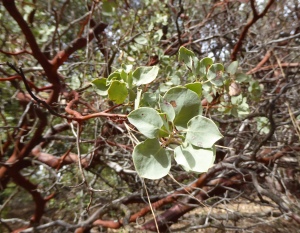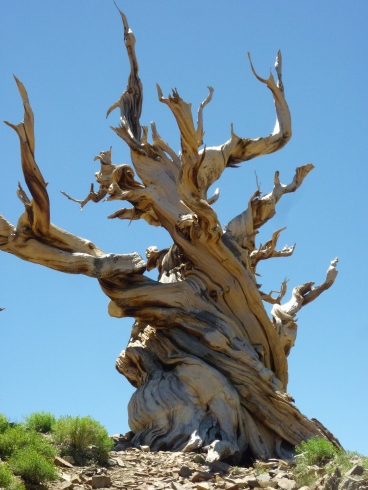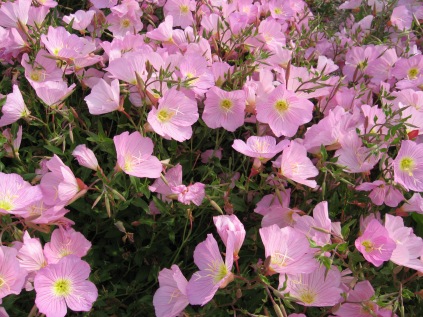
Xerophytes are plants that are xerophilous, which means they have special features that enable them to survive in very dry environments. One of my favorite xerophytes is the Bristlecone Pine, which I wrote about some years ago, calling them Gnarly Patriarchs.

Some of the plants in my home landscape are considered to be xerophilous, though to maintain a xeriscape such as I have it is not necessary to have nothing but xerophytes. A xeriscape, in addition to featuring drought-tolerant plants, uses deep mulches and other means of conserving water besides those that are built into the plants themselves.
In a patch by my driveway, enclosed on all sides by concrete, Mexican Evening Primrose blooms and thrives all summer with a little water once a month or so. It thrives so well that such an enclosed space as it lives in here is usually the best spot for this plant, unless you are okay with it taking over the whole garden.


The picture at right is of warrigal or New Zealand Spinach, an edible green, growing alongside a yellow mystery flower [since discovered to be toadflax], both of which I consider quite xerophilous, as they lived in my back yard for months last summer with no water, and never so much as wilted.
That root xeros comes from the Greek, for dry. My current project is to incorporate more of these unthirsty friends into a plan for my front yard, and I hope to have them planted by the fall.
You’re so knowledgeable about plants, G!
As soon as we get our dirt we will begin this year’s growing!
LikeLiked by 1 person
I, too, like xero-plants for my yard. We *can* have wet years, but mostly, we expect 11″ of rain per year which is considered very dry. I have California poppies which aren’t native, but thrive in the dry, sunny areas. Sunflowers are native, but not the giant ones that I sometimes grow. Lilies do well here, black eyed susan, prairie cone flowers, calendula and cosmos.
I love your Gnarly Patriarch. And the Mexican Evening Primrose, which looks very much like our gumbo lily. I think they are related. Fun post!
LikeLiked by 1 person
I just found out that the native California sunflower that grows along the roadsides and which I have photographed before, as in this post
https://gretchenjoanna.com/2015/10/27/sisters-1-jelly/
is something I can get locally and plant in my front yard!
LikeLike
I remember you telling me about the Gumbo Lily before, and I probably looked it up then, but I had forgotten… so I googled it again and found that you are right, it is related to the Mexican Evening Primrose. GL is Oenothera caespitosa and MEP is Oenothera speciosa 🙂
LikeLike
Your mystery flower looks like something we call butter and eggs, though that may just be a local nickname. 🙂 I love the gnarly patriarch!
LikeLiked by 1 person
Lisa, it IS butter-and-eggs, or toadflax, and Linaria vulgaris is its botanical name. Thank you!! Wikipedia says, “While most commonly found as a weed, toadflax is sometimes cultivated for cut flowers, which are long-lasting in the vase.” It grows like a weed, and looks a little weedy, but maybe I will try to get it going again in my new garden, especially after reading that about it making a good cut flower. Most weed-like plants are not like that!
LikeLike
Just discovered that toadflax is considered Moderately Invasive in California. But I’ve never seen it growing in the wild, and as I live in suburbia anyway, where it unlikely to escape and take over, I may still plant some….
LikeLike
Great post on the letter X, which many would consider a throwaway first letter. Thanks to you and the Greeks! Jules
LikeLiked by 1 person
Your pink evening primrose is beautiful! My husband and I only see our evening primrose (sundrops) on the rock outcrops in this area, we have not seen them anywhere else.
You have lovely flowers where you are!
LikeLiked by 1 person
I never did re-plant toadflax, but it grows profusely anyway!
LikeLike